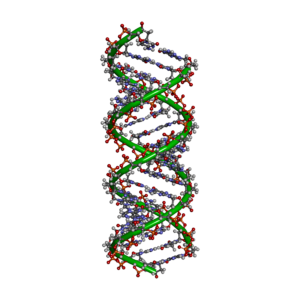DNA
Explanation
DNA or Deoxyribonucleic acid is the molecule found in the cell nucleus of life forms, which functions as a genetic information carrier. DNA contains all the information and instructions on how the basic building block of life, the amino acid, should bond and form complex molecules like proteins. So it technically has the coded instructions or recipe for how each molecule within the cell should be made, which would later govern the nature of the cellular activities and would define the unique traits of every organism on Earth.
DNA is made up of three smaller chemical compounds, a sugar molecule, a phosphate molecule, and four nitrogen containing bases. These three compounds together are called as nucleotides of the DNA. The deoxyribose sugar molecule and the phosphate group are covalently bonded together in a continuous chain, forming the phosphate-deoxyribose backbone. This continuous chain is what is known as a polymer. The repeating unit of the sugar and phosphate molecules are the monomers that makes the polymer. When two of these opposing (or complementary) polymer strands are bonded together with the unbonded nitrogenous bases of those two polymers, in a specific base-pairing sequence, we get the double stranded macromolecule, DNA as shown in the image. The genetic information is thus coded in the form of these unique nucleic acid sequence, which makes the length of a typical DNA (human) as long as 2 to 3 metres. Inside the nucleus, the DNA molecule is packed and wound up along with some proteins as coils in a very compact manner. These coils of DNA forms the chromosomes, which together with the rest of the chromosomes inside the organism forms a unique genome.
Frequently Asked Questions
How are the nitrogenous bases bonded together?
The nitrogenous bases of the two opposing polymer strands bonds together form a hydrogen bond. The bonding occurs only in a certain sequence among the four nitrogenous bases seen in the DNA molecule. The four molecules are adenine (A), thymine (T), guanine (G), and cytosine (C). Adenine always bonds with thymine (uracil (U) in the case of RNA) and guanine with cytosine. Therefore, the base pair is ATGC for DNA and AUGC for RNA. Each organism has a unique order in which these are bonded.
Why adenine always pairs with thymine and guanine always with cytosine?
Adenine and thymine bonds with two hydrogen bond, whereas guanine and cytosine bonds with three hydrogen bonds. The nature of this bonding is due to the molecular structure of these nitrogenous bases. Adenine and thymine are structured in a way that their charge distribution forms two hydrogen bonds with each other and not with guanine or cytosine. The same applies to guanine and cytosine. This type of pairing is generally referred as the Watson-Crick base pairing or complementary base pairing.
Why is the shape of the DNA a double helix?
As seen above, DNA has three parts that make the entire molecule — the sugar, phosphate group, and the nitrogenous base. The helical configuration is the way how the DNA forms to protect the nitrogenous bases from the polar water environment surrounding the cell. As the outer phosphate and sugar molecules are water soluble unlike the nitrogenous base, the favourable state is to form a long chain. And to minimize the exposure of the nitrogenous bases in the centre, the straight strands twist itself to the most favourable helical shape.
What is the difference between DNA and RNA?
DNA's polymer chain is made up of repeating monomers of phosphate and deoxyribose sugar covalently bonded, which are further bonded to the four types of nitrogenous bases — adenine, thymine, guanine, cytosine. This whole strand bonds with another complimentary strand and forms DNA. The single stranded RNA's polymer chain is made up of monomers that have a phosphate group, a ribose sugar and a nitrogenous base of four types — adenine, uracil, guanine, cytosine. The key difference is in the sugar molecule and one of the nitrogenous bases. DNA has a deoxyribose sugar, which is a sugar molecule that lacks an oxygen atom. RNA has a ribose sugar, which is a sugar molecule that has the oxygen atom intact or in other words, has its hydroxyl group intact. As for the nitrogenous bases, as you have seen, RNA has uracil in place of thymine.
How do cells decode and use the genetic information from DNA?
Information in DNA are found in groups of base pairs, each with a specific set of instruction and are generally known as genes. The first step in using these information begins with a process called transcription. Transcription is the process where the genetic information from the DNA gets transcribed to the RNA. The information is transcribed when the RNA enzyme RNA polymerase breaks down the hydrogen bonds between the DNA strands and forms a complementary RNA strand to one of the broken strands of the DNA. When the RNA transcription is complete, the processed and regulated RNA will exit from the nucleus and enter the cytoplasm of the cell through the nuclear pores in the nucleus. Based on the nature of the genetic instruction encoded in the RNA, it can have various functions. For example, an mRNA or messenger RNA carries information on protein synthesis in cells. So in this case, the mRNA will have the sequence of genetic information that will specify the sequence of amino acids to the ribosome — the part of the cell where the instructions from the RNA is decoded and proteins are synthesized. This beautiful and meticulously precise pathway is how the genetic information is used to create wonders inside the cells.


